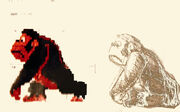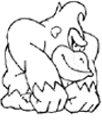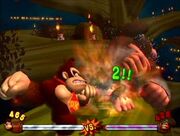Note: there are supposedly two Donkey Kongs. This one will focus on both.
Donkey Kong is a video game icon introduced in the arcade game Donkey Kong in 1981. He was created by Shigeru Miyamoto alongside Mario. After his appearance in Donkey Kong, Nintendo created the successor Donkey Kong Jr. and Donkey Kong 3. Following these popular titles, Nintendo dropped the franchise and went with the hero of the series instead. Then in the nineties Nintendo approached Rare and offered them the chance to revive the Donkey Kong franchise, they accepted and the result was Donkey Kong Country for the SNES.
Donkey Kong is an ape with a red tie that sports his initials. The name Donkey Kong is given to two characters in the Nintendo universe, including the one from the arcade games and the one from the Donkey Kong Country series. The Donkey Kong from arcades is supposedly Cranky Kong according to Rare, and Donkey Kong Jr. is Donkey Kong in the new titles. Some sources claim that Rare's Donkey Kong is actually Donkey Kong Jr.'s son. It seems that Donkey Kong Jr. is in fact the current Donkey Kong, as Cranky Kong has referred to Donkey Kong as his son and an employee at Rare has stated that this was indeed the case through their website, and to close your ears when anyone says otherwise.
History and story
Beginning

Concept art from Donkey Kong.
In 1981, Nintendo's Shigeru Miyamoto was tasked with replacing thousands of unused RadarScope units with a new game. This was Nintendo's last chance in the gaming industry. Gunpei Yokoi assisted Miyamoto in development of the game, which would eventually end up becoming Donkey Kong. The game is best known for being a pioneering platforming game, introducing plot to video games, and featuring multiple levels, among various other things. While the game introduced Donkey Kong, it also was the first game that featured Mario. In Donkey Kong, the disgruntled ape was annoyed of being miss handled by his master Mario. So, he escaped from the carpenters' clutches, kidnapped his girlfriend Pauline, and took refuge on a series of girders at a construction site. Mario took chase and eventually managed to thwart Donkey Kong, afterwards keeping him locked up in a cage. Donkey Kong had a child, however, and he'd take his revenge and save his father in the next game. The name Donkey Kong was created when Shigeru Miyamoto was looking in a Japanese to English dictionary for a word that meant stubborn. He came across the word donkey, which grammatically doesn't make any since, and went with Donkey Kong. Nintendo of America urged them to change the name, though NCL refused.
Donkey Kong did so phenomenally well, selling thousands upon thousands of units, that it generated enough money to warrant a sequel titled Donkey Kong Jr., another arcade title. This game took place directly after the original game and made Mario the enemy. Mario, who took Donkey Kong captive, is trying to make sure that Donkey Kong's son Donkey Kong Jr. doesn't cause any trouble. Donkey Kong Jr., however, manages to find various keys that were used to unlock Donkey Kong's cages. After being rescued, Donkey Kong gave Mario a beating and kicked him off of the stage. In this game's sequel, Donkey Kong 3, Mario wouldn't make an appearance, but Donkey Kong would resort to being the bad guy once more. In the game, he infiltrated a character named Stanley's greenhouse and Stanley must stop him using bug spray. The game wasn't critically acclaimed, which perhaps is due to Miyamoto not working on the title in any way shape or form.
After his arcade appearances, Donkey Kong went on to appear in a variety of remakes, but nothing spectacular or new. He made a cameo appearance in the Nintendo Entertainment System game Mike Tyson's Punch-Out!! as an audience member. There were also remakes of all three Donkey Kong arcade games for the NES as well as one that contained all three of them together in a game called Donkey Kong Classics. Overall, though, Donkey Kong went virtually unnoticed in the NES era, though this wouldn't be the case come the Super Nintendo Entertainment System.
Rare revives the franchise
European game developer Rare was a well known video game developer, and when the SNES was released Nintendo approached them with an offer to develop a new Donkey Kong title. Due to the series' success in arcades, Rare felt that they would find most success if they revived Donkey Kong. But they weren't satisfied to doing just that, and made what was considered the most impressive graphics engine on the SNES. With pseudo 3D renders, Donkey Kong Country was sure to find success when it was released, and it most certainly did. So much that two sequels to the game were created and various remakes.

Concept art for the new Donkey Kong.
But, there were a few things that players had to keep in mind when playing. First, this was not the same Donkey Kong that Mario fought in the original arcade classic. Rather, this was either Donkey Kong Jr. or Donkey Kong Jr.'s son. Most sources point to the former. The Donkey Kong from the original game was now known as Cranky Kong, an old monkey who is now skin and bones that has a cane. Donkey Kong also looked a lot different from the Donkey Kong in the original. There were various other things that the series introduced, such as a new villain named King K. Rool. Mario was completely omitted from the game series save for a trophy cameo.
Oddly, Donkey Kong would not appear as a playable character in this game's sequels. Rather, it would be some of the characters from the previous titles and brand new ones too. In these games Donkey Kong would be the one who would be kidnapped by King K. Rool. King K. Rool in the first game stole Donkey Kong's banana hoard. While his motives were unclear, an employee of Rare said that without any bananas to eat, Donkey Kong would die of starvation. So, it was only natural that Donkey Kong and his pal Diddy Kong would go out to reclaim their treasure.
Following the SNES era of games, Donkey Kong went on to appear in Donkey Kong 64 for the Nintendo 64. In this game, he and a bunch of buddies team up to take down King K. Rool, who managed to construct a device capable of destroying Donkey Kong Isle, where they all reside. The ship that the machine was on crashed on a rock, and halted the progress of their plans, giving Donkey Kong the time to go and thwart him once again.
Rare leaves, the series continues on
In the early 2000s, Nintendo did a surprising move and sold Rare to competitor Microsoft. An era had ended, though the series that they revived would continue on. Nintendo bought the characters that Rare had created through the Donkey Kong series, most notably Diddy Kong, Dixie Kong, and King K. Rool, and continued to manufacture, publish, and on rare occasions even develop new Donkey Kong games. Their first venture post Rare was a series developed in conjunction with Namco titled Donkey Konga. A music title, this game came with set of DK Bongos. A DK Bongo had two drums and could hear when the player clapped. The player would have to keep with the rhythm in the game by drumming and clapping. In all there were three games released in the series, including Donkey Konga, Donkey Konga 2, and Donkey Konga 3, the latter game being released exclusively in Japan.
Meanwhile, Paon was given rights to develop Donkey Kong games, and created DK King of Swing, Donkey Kong: Jungle Climber and Donkey Kong: Barrel Blast for the Game Boy Advance, Nintendo DS, and Wii, respectively. The two former games were part of a series of games where Donkey Kong and crew would grasp onto spheres hanging in mid air and climb to the top of stages. The games were greatly compared to the NES classic Clu Clu Land, which was developed by Nintendo. Donkey Kong: Jungle Beat for Wii was critically panned and was considered by many as too hard to control.

Donkey Kong was redesigned yet again for Jungle Beat.
Nintendo Software Technology in Redmond, Washington created Mario vs. Donkey Kong for the Game Boy Advance in 2004. This game reunited the original cast of Donkey Kong excluding Pauline, albeit the Donkey Kong used in this game was the one that Rare created. This is confusing, however, as they made it seem like it was the same one present in the original arcade classic. The game was successful and the developers ended up creating a sequel for the Nintendo DS titled Mario vs. Donkey Kong 2: March of the Minis, which actually featured Pauline. In the game, Donkey Kong would once again kidnap Pauline, and Mario, using miniature toys, would have to save her.
Perhaps the most notable Donkey Kong game released after Rare's departure was a game developed by the then new Nintendo EAD Tokyo, the fifth Nintendo EAD division. The team created the GameCube title Donkey Kong Jungle Beat, which was controlled via the DK Bongos Namco and Nintendo made for Donkey Konga. The game could also be controlled with the GameCube controller, though most agree that it isn't nearly as enjoyable. The game was a sidescrolling platformer like the Donkey Kong Country games and gave Donkey Kong a slightly new look. It was highly praised among critics, though unfortunately didn't manage to sell a million units. The game was later remade for the Wii under the title New Play Control! Donkey Kong Jungle Beat, and featured numerous updates. Nintendo EAD Tokyo would go on to create the best seller Super Mario Galaxy on the Wii.
Outside appearances
Donkey Kong has made various appearances outside of his franchise. He is a regular character in the Super Smash Bros. franchise and was an opponent in Punch-Out!! for the Wii. He has appeared in many different Mario spinoffs such as all post-Super Mario Kart Mario Kart games, sports titles and the Party games. A baby version of Donkey Kong, appropriately known as Baby Donkey Kong, was one of the five characters that would ride on top of Yoshi in the Nintendo DS video game Yoshi's Island DS. He would give Yoshi new abilities such as crashing through blocks and climbing up vines, though his weight also posed a problem.
Super Smash Bros. series
Donkey Kong is has appeared in every Super Smash Bros. video game thus far, which includes Super Smash Bros. on the Nintendo 64, Super Smash Bros. Melee on the GameCube, and Super Smash Bros. Brawl on the Wii. In all three titles he is among the strongest and heaviest characters in the game. His standard B move, known as Giant Punch, was so potent that when fully charged it could deliver 36% damage to a character. His recovery move is titled Spinning Kong which will cause him to spin around so quickly that it'll send him soaring in the air. His down B move is Hand Slap, which will make him continuously pound the ground until the player wishes for him not to. In all games after Super Smash Bros., Donkey Kong can perform Headbutt when the player presses right or left on the joystick in combination with the B button.
Trophy descriptions
- Melee: "While he now prefers the laid-back jungle lifestyle to construction site mischief, DK is often forced back into action by the Kremling Krew. The great ape is quite fast despite his burly physique, and he keeps his strength up with a steady diet of his favorite food: bananas. His one extravagance (and only piece of clothing) is a monogrammed necktie."
- Melee (Smash Red): "Donkey Kong is a huge target in a fight, so he hates crowds. When he's in the fray, his Giant Punch deals serious damage to multiple opponents. The big ape's Headbutt hits so hard that it temporarily buries opponent's in the ground. DK is a lot faster than he looks, and he's lethal in the hands of a master. (B: Giant Punch, Smash B: Headbutt)"
- Melee (Smash Blue): " Being the strongest simian around, DK has the upper hand once he grabs an opponent. He can even lift his foe up and make him or her an unwilling traveling companion; if DK grabs you, shake your Control Stick as fast as you can to break his grip. His Spinning Kong covers more lateral distance than vertical, so use it quickly to recover. (Up & B: Spinning Kong, Down & B: Hand Slap)"
- Brawl: "A carefree jungle dweller with the charisma of a natural leader. He keeps busy by foiling the plans of the Kremlings and their boss, King K. Rool. As his physique suggests, this ape is a powerhouse. He's got speed to match too, and his love for bananas is second to none. His famous necktie is adorned with his initials, DK."
Sports games
Donkey Kong has appeared in many Mario sports titles that aren't considered Donkey Kong games. Because of his many appearances in these games, he is often called one of the "Big Eight": eight Mario characters who commonly appear in games together. The others include Mario, Luigi, Princess Peach, Yoshi, Bowser, Toad, and Wario. In the sports titles Donkey Kong has appeared in all of the Mario Golf games, all kart racing titles excluding Super Mario Kart, and the tennis, baseball, soccer, and basketball games. He is commonly one of the heaviest playable characters in the titles. Donkey Kong appeared in a beta version of Mario & Sonic at the Olympic Games and was officially confirmed for Mario & Sonic at the Olympic Winter Games at E3 2009 along with Metal Sonic.
Donkey Kong also appeared as an opponent in Punch-Out!! for the Wii as the final character in the game that you could fight. The character is extremely challenging to unlock, as the player can only fight him after getting through the Last Stand mode.
| Characters in Donkey Kong | |
|---|---|
| Major Kongs | Candy Kong • Chunky Kong • Cranky Kong • Diddy Kong • Dixie Kong • Donkey Kong • Donkey Kong Jr. • Funky Kong • Kiddy Kong • Lanky Kong • Swanky Kong • Tiny Kong • Wrinkly Kong |
| Other Kongs | Manky Kong • Bluster Kong • Leo Luster • Dread Kong • Eddie the Mean Old Yeti • Karate Kong • Kong Fu • Ninja Kong • Sumo Kong |
| Kremlings | King K. Rool • Kaptain Skurvy • Green Kroc • Kalypso • Kasplat • Kass • Kerozene • Kip • K. Lumsy • Klubba • Kludge • Klump • Kopter • Krusha • Kudgel • Kackle • Kritter • Klaptrap |
| Tiki Tak Tribe | Kalimba • Maraca Gang • Gong-Oh • Banjo Bottom • Wacky Pipes • Xylobone • Cordian • Tiki Tong |
| Snowmads | Pompy • Skowl • Ba-Boom • Fugu • Bashmaster • Lord Fredrik |
| Characters in Mario | |
|---|---|
| Major characters | The Mario Bros. (Mario • Luigi) • Princess Peach • Toad • Yoshi • Bowser • Bowser Jr. • Rosalina • Waluigi • Princess Daisy • Toadette • Birdo • Wario • Donkey Kong • Diddy Kong |
| Secondary characters | Wanda • Pauline • Professor E. Gadd • Toadsworth • Captain Toad • Nabbit • Cappy |
| Enemies | Koopalings (Larry Koopa / Morton Koopa Jr. / Lemmy Koopa / Wendy O. Koopa / Iggy Koopa / Roy Koopa / Ludwig von Koopa) • Fawful • Kammy Koopa • Dimentio • Antasma • Kamek • King Boo • Petey Piranha • Tatanga • Wart • Foreman Spike • Koopa Troopa • Dry Bones • Goomba • Piranha Plant • Boo |
| Other media | Giuseppe |
